
Bayon
Encyclopedia
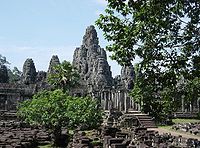

Khmer Empire
The Khmer Empire was one of the most powerful empires in Southeast Asia. The empire, which grew out of the former kingdom of Chenla, at times ruled over and/or vassalized parts of modern-day Laos, Thailand, Vietnam, Burma, and Malaysia. Its greatest legacy is Angkor, the site of the capital city...
temple at Angkor
Angkor
Angkor is a region of Cambodia that served as the seat of the Khmer Empire, which flourished from approximately the 9th to 15th centuries. The word Angkor is derived from the Sanskrit nagara , meaning "city"...
in Cambodia
Cambodia
Cambodia , officially known as the Kingdom of Cambodia, is a country located in the southern portion of the Indochina Peninsula in Southeast Asia...
. Built in the late 12th century or early 13th century as the official state temple of the Mahayana
Mahayana
Mahāyāna is one of the two main existing branches of Buddhism and a term for classification of Buddhist philosophies and practice...
Buddhist King Jayavarman VII
Jayavarman VII
Jayavarman VII was a king of the Khmer Empire in present day Siem Reap, Cambodia. He was the son of King Dharanindravarman II and Queen Sri Jayarajacudamani. He married Jayarajadevi and then, after her death, married her sister Indradevi...
, the Bayon stands at the centre of Jayavarman's capital, Angkor Thom
Angkor Thom
Angkor Thom , located in present day Cambodia, was the last and most enduring capital city of the Khmer empire. It was established in the late twelfth century by king Jayavarman VII. It covers an area of 9 km², within which are located several monuments from earlier eras as well as those...
. Following Jayavarman's death, it was modified and augmented by later Hindu
Hindu
Hindu refers to an identity associated with the philosophical, religious and cultural systems that are indigenous to the Indian subcontinent. As used in the Constitution of India, the word "Hindu" is also attributed to all persons professing any Indian religion...
and Theravada
Theravada
Theravada ; literally, "the Teaching of the Elders" or "the Ancient Teaching", is the oldest surviving Buddhist school. It was founded in India...
Buddhist kings in accordance with their own religious preferences.
The Bayon's most distinctive feature is the multitude of serene and massive stone faces on the many towers which jut out from the upper terrace and cluster around its central peak. The temple is known also for two impressive sets of bas-reliefs, which present an unusual combination of mythological
Itihasa
Itihasa as defined by Amarakosha refers to purvavritta, i.e. events of the past. In the Vedic age, those portions of the Brahmanas which narrated events of bygone days were known as itihasa and had some ritualistic importance...
, historical, and mundane scenes. The current main conservatory body, the Japanese Government team for the Safeguarding of Angkor
Angkor
Angkor is a region of Cambodia that served as the seat of the Khmer Empire, which flourished from approximately the 9th to 15th centuries. The word Angkor is derived from the Sanskrit nagara , meaning "city"...
(the JSA) has described the temple as "the most striking expression of the baroque style" of Khmer architecture, as contrasted with the classical style of Angkor Wat
Angkor Wat
Angkor Wat is a temple complex at Angkor, Cambodia, built for the king Suryavarman II in the early 12th century as his state temple and capital city. As the best-preserved temple at the site, it is the only one to have remained a significant religious centre since its foundation – first Hindu,...
.
Buddhist symbolism in the foundation of the temple by King Jayavarman VII
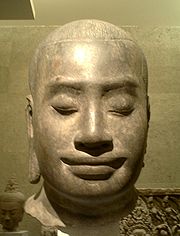
Angkor
Angkor is a region of Cambodia that served as the seat of the Khmer Empire, which flourished from approximately the 9th to 15th centuries. The word Angkor is derived from the Sanskrit nagara , meaning "city"...
, and the only Angkorian state temple to be built primarily as a Mahayana Buddhist shrine dedicated to the Buddha
Buddha
In Buddhism, buddhahood is the state of perfect enlightenment attained by a buddha .In Buddhism, the term buddha usually refers to one who has become enlightened...
, though a great number of minor and local deities were also encompassed as representatives of the various districts and cities of the realm. It was the centrepiece of Jayavarman VII
Jayavarman VII
Jayavarman VII was a king of the Khmer Empire in present day Siem Reap, Cambodia. He was the son of King Dharanindravarman II and Queen Sri Jayarajacudamani. He married Jayarajadevi and then, after her death, married her sister Indradevi...
's massive program of monumental construction and public works, which was also responsible for the walls and nāga
Naga
Naga or NAGA may refer to:* Nāga, a group of serpent deities in Hindu and Buddhist mythology.-People:* Nayan / Nayar/Nair people of Kerala Society* Naga people, a diverse ethnic identity in Northeast India...
-bridges of Angkor Thom
Angkor Thom
Angkor Thom , located in present day Cambodia, was the last and most enduring capital city of the Khmer empire. It was established in the late twelfth century by king Jayavarman VII. It covers an area of 9 km², within which are located several monuments from earlier eras as well as those...
and the temples of Preah Khan
Preah Khan
Preah Khan , sometimes transliterated as Prah Khan, is a temple at Angkor, Cambodia, built in the 12th century for King Jayavarman VII. It is located northeast of Angkor Thom and just west of the Jayatataka baray, with which it was associated. It was the centre of a substantial organisation,...
, Ta Prohm
Ta Prohm
Ta Prohm is the modern name of a temple at Angkor, Siem Reap Province, Cambodia, built in the Bayon style largely in the late 12th and early 13th centuries and originally called Rajavihara...
and Banteay Kdei
Banteay Kdei
Banteay Kdei , meaning "A Citadel of Chambers", also known as "Citadel of Monks' cells", is a Buddhist temple in Angkor, Cambodia. It is located southeast of Ta Prohm and east of Angkor Thom...
.
The similarity of the 216 gigantic faces on the temple's towers to other statues of the king has led many scholars to the conclusion that the faces are representations of Jayavarman VII
Jayavarman VII
Jayavarman VII was a king of the Khmer Empire in present day Siem Reap, Cambodia. He was the son of King Dharanindravarman II and Queen Sri Jayarajacudamani. He married Jayarajadevi and then, after her death, married her sister Indradevi...
himself. Others have said that the faces belong to the bodhisattva
Bodhisattva
In Buddhism, a bodhisattva is either an enlightened existence or an enlightenment-being or, given the variant Sanskrit spelling satva rather than sattva, "heroic-minded one for enlightenment ." The Pali term has sometimes been translated as "wisdom-being," although in modern publications, and...
of compassion called Avalokitesvara
Avalokitesvara
Avalokiteśvara is a bodhisattva who embodies the compassion of all Buddhas. He is one of the more widely revered bodhisattvas in mainstream Mahayana Buddhism....
or Lokesvara. The two hypotheses need not be regarded as mutually exclusive. Angkor scholar George Coedès
George Coedès
Georges Cœdès was a 20th century scholar of southeast Asian archaeology and history. Coedès was born in Paris to a family of supposed Hungarian-Jewish emigres. In fact, the family was known as having settled in the region of Strasbourg before 1740. His ancestors were working for the royal Treasury...
has theorized that Jayavarman stood squarely in the tradition of the Khmer monarchs in thinking of himself as a "devaraja" (god-king), the salient difference being that while his predecessors were Hindus and regarded themselves as consubstantial with Shiva
Shiva
Shiva is a major Hindu deity, and is the destroyer god or transformer among the Trimurti, the Hindu Trinity of the primary aspects of the divine. God Shiva is a yogi who has notice of everything that happens in the world and is the main aspect of life. Yet one with great power lives a life of a...
and his symbol the lingam
Lingam
The Lingam is a representation of the Hindu deity Shiva used for worship in temples....
, Jayavarman as a Buddhist identified himself with the Buddha
Gautama Buddha
Siddhārtha Gautama was a spiritual teacher from the Indian subcontinent, on whose teachings Buddhism was founded. In most Buddhist traditions, he is regarded as the Supreme Buddha Siddhārtha Gautama (Sanskrit: सिद्धार्थ गौतम; Pali: Siddhattha Gotama) was a spiritual teacher from the Indian...
and the bodhisattva
Bodhisattva
In Buddhism, a bodhisattva is either an enlightened existence or an enlightenment-being or, given the variant Sanskrit spelling satva rather than sattva, "heroic-minded one for enlightenment ." The Pali term has sometimes been translated as "wisdom-being," although in modern publications, and...
.
Alterations following the death of Jayavarman VII
Since the time of Jayavarman VIIJayavarman VII
Jayavarman VII was a king of the Khmer Empire in present day Siem Reap, Cambodia. He was the son of King Dharanindravarman II and Queen Sri Jayarajacudamani. He married Jayarajadevi and then, after her death, married her sister Indradevi...
, the Bayon has suffered numerous additions and alterations at the hands of subsequent monarchs. During the reign of Jayavarman VIII
Jayavarman VIII
Jayavarman VIII was one of the kings of the Khmer empire. His rule lasted from 1243 till 1295, when he abdicated.It was during the reign of Jayavarman VIII that the Mongol forces under the command of Kublai Khan attacked the Angkor empire in 1283. Jayavarman VIII decided to pay tribute and buy...
in the mid-13th century, the Khmer empire
Khmer Empire
The Khmer Empire was one of the most powerful empires in Southeast Asia. The empire, which grew out of the former kingdom of Chenla, at times ruled over and/or vassalized parts of modern-day Laos, Thailand, Vietnam, Burma, and Malaysia. Its greatest legacy is Angkor, the site of the capital city...
reverted to Hinduism
Hinduism
Hinduism is the predominant and indigenous religious tradition of the Indian Subcontinent. Hinduism is known to its followers as , amongst many other expressions...
and its state temple was altered accordingly. In later centuries, Theravada Buddhism became the dominant religion, leading to still further changes, before the temple was eventually abandoned to the jungle. Current features which were not part of the original plan include the terrace to the east of the temple, the libraries, the square corners of the inner gallery, and parts of the upper terrace.
Modern restoration and scholarship
In the first part of the 20th century, the École Française d'Extrême Orient took the lead in the conservation of the temple, restoring it in accordance with the technique of anastylosisAnastylosis
Anastylosis is an archaeological term for a reconstruction technique whereby a ruined building or monument is restored using the original architectural elements to the greatest degree possible...
. Since 1995 the Japanese Government team for the Safeguarding of Angkor (the JSA) has been the main conservatory body, and has held annual symposia.
The site
The temple is orientated towards the east, and so its buildings are set back to the west inside enclosures elongated along the east-west axis. Because the temple sits at the exact centre of Angkor ThomAngkor Thom
Angkor Thom , located in present day Cambodia, was the last and most enduring capital city of the Khmer empire. It was established in the late twelfth century by king Jayavarman VII. It covers an area of 9 km², within which are located several monuments from earlier eras as well as those...
, roads lead to it directly from the gates at each of the city's cardinal points. The temple itself has no wall or moat
Moat
A moat is a deep, broad ditch, either dry or filled with water, that surrounds a castle, other building or town, historically to provide it with a preliminary line of defence. In some places moats evolved into more extensive water defences, including natural or artificial lakes, dams and sluices...
s, these being replaced by those of the city itself: the city-temple arrangement, with an area of 9 square kilometres, is much larger than that of Angkor Wat
Angkor Wat
Angkor Wat is a temple complex at Angkor, Cambodia, built for the king Suryavarman II in the early 12th century as his state temple and capital city. As the best-preserved temple at the site, it is the only one to have remained a significant religious centre since its foundation – first Hindu,...
to the south (2 km²).
Within the temple itself, there are two galleried enclosures (the third and second enclosures) and an upper terrace (the first enclosure). All of these elements are crowded against each other with little space between. Unlike Angkor Wat
Angkor Wat
Angkor Wat is a temple complex at Angkor, Cambodia, built for the king Suryavarman II in the early 12th century as his state temple and capital city. As the best-preserved temple at the site, it is the only one to have remained a significant religious centre since its foundation – first Hindu,...
, which impresses with the grand scale of its architecture and open spaces, the Bayon "gives the impression of being compressed within a frame which is too tight for it."
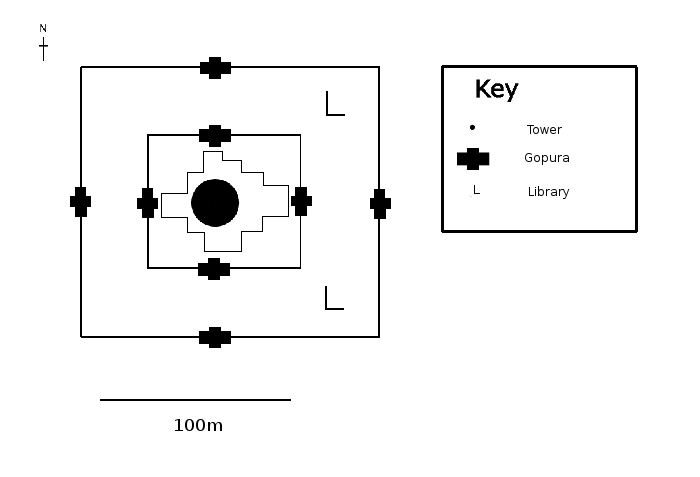
The outer gallery: depictions of historical events and everyday life
The outer wall of the outer gallery features a series of bas-reliefs depicting historical events and scenes from the everyday life of the Angkorian Khmer. Though highly detailed and informative in themselves, the bas-reliefs are not accompanied by any sort of epigraphic text, and for that reason considerable uncertainty remains as to which historical events are portrayed and how, if at all, the different reliefs are related. From the east gopura clockwise, the subjects are: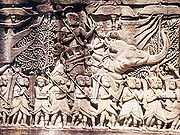
- in the southern part of the eastern gallery a marching KhmerKhmer EmpireThe Khmer Empire was one of the most powerful empires in Southeast Asia. The empire, which grew out of the former kingdom of Chenla, at times ruled over and/or vassalized parts of modern-day Laos, Thailand, Vietnam, Burma, and Malaysia. Its greatest legacy is Angkor, the site of the capital city...
army (including some ChineseChinaChinese civilization may refer to:* China for more general discussion of the country.* Chinese culture* Greater China, the transnational community of ethnic Chinese.* History of China* Sinosphere, the area historically affected by Chinese culture...
soldiers), with musicians, horsemen, and officers mounted on elephants, followed by wagons of provisions;


- still in the eastern gallery, on the other side of the doorway leading into the courtyard, another procession followed by domestic scenes depicting Angkorian houses, some of the occupants of which appear to be Chinese merchants;
- in the southeast corner pavilion, an unfinished temple scene with towers, apsaras, and a lingamLingamThe Lingam is a representation of the Hindu deity Shiva used for worship in temples....
; - in the eastern part of the southern gallery, a naval battle on the Tonle SapTonlé SapThe Tonlé Sap is a combined lake and river system of major importance to Cambodia.The Tonlé Sap is the largest freshwater lake in South East Asia and is an ecological hot spot that was designated as a UNESCO biosphere in 1997....
between Khmer and Cham forces, underneath which are more scenes from civilian life depicting a market, open-air cooking, hunters, and women tending to children and an invalid; - still in the southern gallery, past the doorway leading to the courtyard, a scene with boats and fisherman, including a Chinese junk, below which is a depiction of a cockfight; then some palace scenes with princesses, servants, people engaged in conversations and games, wrestlers, and a wild boar fight; then a battle scene with Cham warriors disembarking from boats and engaging Khmer warriors whose bodies are protected by coiled ropes, followed by a scene in which the Khmer dominate the combat, followed by a scene in which the Khmer king celebrates a victory feast with his subjects;
- in the western part of the southern gallery, a military procession including both Khmers and Chams, elephants, war machines such as a large crossbow and a catapult;
- in the southern part of the western gallery, unfinished reliefs show an army marching through the forest, then arguments and fighting between groups of Khmers;
- in the western gallery, past the doorway to the courtyard, a scene depicting a melee between Khmer warriors, then a scene in which warriors pursue others past a pool in which an enormous fish swallows a small deer; then a royal procession, with the king standing on an elephant, preceded by the ark of the sacred flame;
- in the western part of the northern gallery, again unfinished, a scene of royal entertainment including athletes, jugglers and acrobats, a procession of animals, ascetics sitting in a forest, and more battles between Khmer and Cham forces;
- in the northern gallery, past the doorway to the courtyard, a scene in which the Khmer flee from Cham soldiers advancing in tight ranks;
- in the northeast corner pavilion, another marching Khmer army;
- in the eastern gallery, a land battle between Khmer and Cham forces, both of which are supported by elephants: the Khmer appear to be winning.
The outer gallery encloses a courtyard in which there are two libraries (one on either side of the east entrance). Originally the courtyard contained 16 chapels, but these were subsequently demolished by the Hindu restorationist Jayavarman VIII
Jayavarman VIII
Jayavarman VIII was one of the kings of the Khmer empire. His rule lasted from 1243 till 1295, when he abdicated.It was during the reign of Jayavarman VIII that the Mongol forces under the command of Kublai Khan attacked the Angkor empire in 1283. Jayavarman VIII decided to pay tribute and buy...
.
The inner gallery: depictions of mythological events
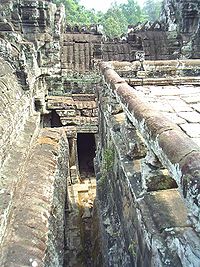
Hindu mythology
Hindu religious literature is the large body of traditional narratives related to Hinduism, notably as contained in Sanskrit literature, such as the Sanskrit epics and the Puranas. As such, it is a subset of Nepali and Indian culture...
. Some of the figures depicted are Siva
Shiva
Shiva is a major Hindu deity, and is the destroyer god or transformer among the Trimurti, the Hindu Trinity of the primary aspects of the divine. God Shiva is a yogi who has notice of everything that happens in the world and is the main aspect of life. Yet one with great power lives a life of a...
, Vishnu
Vishnu
Vishnu is the Supreme god in the Vaishnavite tradition of Hinduism. Smarta followers of Adi Shankara, among others, venerate Vishnu as one of the five primary forms of God....
, and Brahma
Brahma
Brahma is the Hindu god of creation and one of the Trimurti, the others being Vishnu and Shiva. According to the Brahma Purana, he is the father of Mānu, and from Mānu all human beings are descended. In the Ramayana and the...
, the members of the trimurti
Trimurti
The Trimurti is a concept in Hinduism "in which the cosmic functions of creation, maintenance, and destruction are personified by the forms of Brahmā the creator, Vishnu the maintainer or preserver, and Śhiva the destroyer or transformer," These three deities have been called "the Hindu triad" or...
or threefold godhead of Hinduism
Hinduism
Hinduism is the predominant and indigenous religious tradition of the Indian Subcontinent. Hinduism is known to its followers as , amongst many other expressions...
, Apsaras or celestial dancers, Ravana
Ravana
' is the primary antagonist character of the Hindu legend, the Ramayana; who is the great king of Lanka. In the classic text, he is mainly depicted negatively, kidnapping Rama's wife Sita, to claim vengeance on Rama and his brother Lakshmana for having cut off the nose of his sister...
and Garuda
Garuda
The Garuda is a large mythical bird or bird-like creature that appears in both Hindu and Buddhist mythology.From an Indian perspective, Garuda is the Hindu name for the constellation Aquila and...
. There is however no certainty as to what some of the panels depict, or as to their relationship with one another. One gallery just north of the eastern gopura, for example, shows two linked scenes which have been explained as the freeing of a goddess from inside a mountain, or as an act of iconoclasm by Cham invaders. Another series of panels shows a king fighting a gigantic serpent with his bare hands, then having his hands examined by women, and finally lying ill in bed; these images have been connected with the legend of the Leper King, who contracted leprosy from the venom of a serpent with whom he had done battle. Less obscure are depictions of the construction of a Vishnu
Vishnu
Vishnu is the Supreme god in the Vaishnavite tradition of Hinduism. Smarta followers of Adi Shankara, among others, venerate Vishnu as one of the five primary forms of God....
ite temple (south of the western gopura) and the Churning of the Sea of Milk
Samudra manthan
In Hinduism, Samudra manthan or Ksheera Sagara Mathanam, Churning of the Ocean of Milk is one of the most famous episodes in the Puranas...
(north of the western gopura).
The upper terrace: 200 faces of Lokesvara
The inner gallery is nearly filled by the upper terrace, raised one level higher again. The lack of space between the inner gallery and the upper terrace has led scholars to conclude that the upper terrace did not figure in the original plan for the temple, but that it was added shortly thereafter following a change in design. Originally, it is believed, the Bayon had been designed as a single-level structure, similar in that respect to the roughly contemporaneous foundations at Ta ProhmTa Prohm
Ta Prohm is the modern name of a temple at Angkor, Siem Reap Province, Cambodia, built in the Bayon style largely in the late 12th and early 13th centuries and originally called Rajavihara...
and Banteay Kdei
Banteay Kdei
Banteay Kdei , meaning "A Citadel of Chambers", also known as "Citadel of Monks' cells", is a Buddhist temple in Angkor, Cambodia. It is located southeast of Ta Prohm and east of Angkor Thom...
.
The upper terrace is home to the famous "face towers" of the Bayon, each of which supports two, three or (most commonly) four gigantic smiling faces. In addition to the mass of the central tower, smaller towers are located along the inner gallery (at the corners and entrances), and on chapels on the upper terrace. "Wherever one wanders," writes Maurice Glaize
Maurice Glaize
Maurice Glaize was a French architect and archeologist, Conservator of Angkor from 1937 to 1945.-Early years: education, wedding, war and professional experiences:...
, the faces of Lokesvara follow and dominate with their multiple presence."
Efforts to read some significance into the numbers of towers and faces have run up against the circumstance that these numbers have not remained constant over time, as towers have been added through construction and lost to attrition. At one point, the temple was host to 49 such towers; now only 37 remain. The number of faces is approximately 200, but since some are only partially preserved there can be no definitive count.
The central tower and sanctuary
Like the inner gallery, the central tower was originally cruciform but was later filled out and made circular. It rises 43 metres above the ground. At the time of the temple's foundation, the principal religious image was a statue of the BuddhaBuddha
In Buddhism, buddhahood is the state of perfect enlightenment attained by a buddha .In Buddhism, the term buddha usually refers to one who has become enlightened...
, 3.6 m tall, located in the sanctuary
Sanctuary
A sanctuary is any place of safety. They may be categorized into human and non-human .- Religious sanctuary :A religious sanctuary can be a sacred place , or a consecrated area of a church or temple around its tabernacle or altar.- Sanctuary as a sacred place :#Sanctuary as a sacred place:#:In...
at the heart of the central tower. The statue depicted the Buddha seated in meditation, shielded from the elements by the flared hood of the serpent king Mucalinda
Mucalinda
Mucalinda, Muchalinda or Mucilinda is the name of a naga , who protected the Buddha from the elements after his enlightenment....
. During the reign of Hindu restorationist monarch Jayavarman VIII
Jayavarman VIII
Jayavarman VIII was one of the kings of the Khmer empire. His rule lasted from 1243 till 1295, when he abdicated.It was during the reign of Jayavarman VIII that the Mongol forces under the command of Kublai Khan attacked the Angkor empire in 1283. Jayavarman VIII decided to pay tribute and buy...
, the figure was removed from the sanctuary and smashed to pieces. After being recovered in 1933 from the bottom of a well, it was pieced back together, and is now on display in a small pavilion at Angkor
Angkor
Angkor is a region of Cambodia that served as the seat of the Khmer Empire, which flourished from approximately the 9th to 15th centuries. The word Angkor is derived from the Sanskrit nagara , meaning "city"...
.

